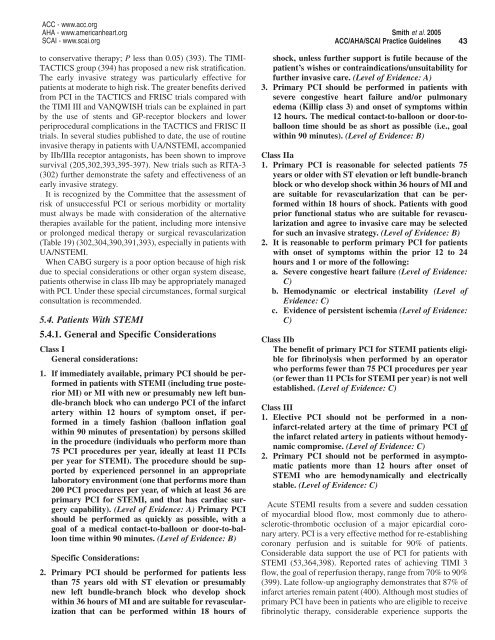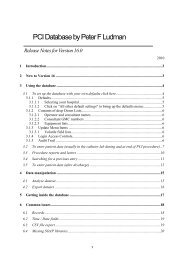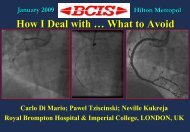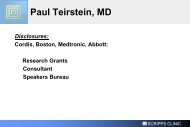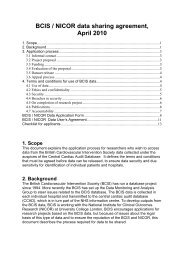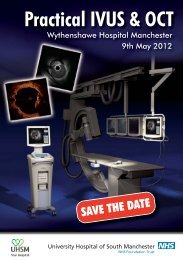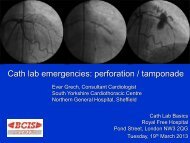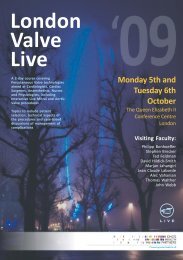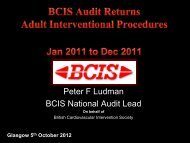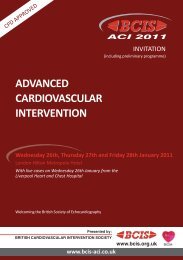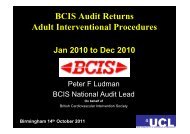Recommendations
ACC/AHA/SCAI PCI Guidelines - British Cardiovascular Intervention ...
ACC/AHA/SCAI PCI Guidelines - British Cardiovascular Intervention ...
- No tags were found...
You also want an ePaper? Increase the reach of your titles
YUMPU automatically turns print PDFs into web optimized ePapers that Google loves.
ACC - www.acc.org<br />
AHA - www.americanheart.org<br />
SCAI - www.scai.org<br />
Smith et al. 2005<br />
ACC/AHA/SCAI Practice Guidelines<br />
43<br />
to conservative therapy; P less than 0.05) (393). The TIMI-<br />
TACTICS group (394) has proposed a new risk stratification.<br />
The early invasive strategy was particularly effective for<br />
patients at moderate to high risk. The greater benefits derived<br />
from PCI in the TACTICS and FRISC trials compared with<br />
the TIMI III and VANQWISH trials can be explained in part<br />
by the use of stents and GP-receptor blockers and lower<br />
periprocedural complications in the TACTICS and FRISC II<br />
trials. In several studies published to date, the use of routine<br />
invasive therapy in patients with UA/NSTEMI, accompanied<br />
by IIb/IIIa receptor antagonists, has been shown to improve<br />
survival (205,302,393,395-397). New trials such as RITA-3<br />
(302) further demonstrate the safety and effectiveness of an<br />
early invasive strategy.<br />
It is recognized by the Committee that the assessment of<br />
risk of unsuccessful PCI or serious morbidity or mortality<br />
must always be made with consideration of the alternative<br />
therapies available for the patient, including more intensive<br />
or prolonged medical therapy or surgical revascularization<br />
(Table 19) (302,304,390,391,393), especially in patients with<br />
UA/NSTEMI.<br />
When CABG surgery is a poor option because of high risk<br />
due to special considerations or other organ system disease,<br />
patients otherwise in class IIb may be appropriately managed<br />
with PCI. Under these special circumstances, formal surgical<br />
consultation is recommended.<br />
5.4. Patients With STEMI<br />
5.4.1. General and Specific Considerations<br />
Class I<br />
General considerations:<br />
1. If immediately available, primary PCI should be performed<br />
in patients with STEMI (including true posterior<br />
MI) or MI with new or presumably new left bundle-branch<br />
block who can undergo PCI of the infarct<br />
artery within 12 hours of symptom onset, if performed<br />
in a timely fashion (balloon inflation goal<br />
within 90 minutes of presentation) by persons skilled<br />
in the procedure (individuals who perform more than<br />
75 PCI procedures per year, ideally at least 11 PCIs<br />
per year for STEMI). The procedure should be supported<br />
by experienced personnel in an appropriate<br />
laboratory environment (one that performs more than<br />
200 PCI procedures per year, of which at least 36 are<br />
primary PCI for STEMI, and that has cardiac surgery<br />
capability). (Level of Evidence: A) Primary PCI<br />
should be performed as quickly as possible, with a<br />
goal of a medical contact-to-balloon or door-to-balloon<br />
time within 90 minutes. (Level of Evidence: B)<br />
Specific Considerations:<br />
2. Primary PCI should be performed for patients less<br />
than 75 years old with ST elevation or presumably<br />
new left bundle-branch block who develop shock<br />
within 36 hours of MI and are suitable for revascularization<br />
that can be performed within 18 hours of<br />
shock, unless further support is futile because of the<br />
patient’s wishes or contraindications/unsuitability for<br />
further invasive care. (Level of Evidence: A)<br />
3. Primary PCI should be performed in patients with<br />
severe congestive heart failure and/or pulmonary<br />
edema (Killip class 3) and onset of symptoms within<br />
12 hours. The medical contact-to-balloon or door-toballoon<br />
time should be as short as possible (i.e., goal<br />
within 90 minutes). (Level of Evidence: B)<br />
Class IIa<br />
1. Primary PCI is reasonable for selected patients 75<br />
years or older with ST elevation or left bundle-branch<br />
block or who develop shock within 36 hours of MI and<br />
are suitable for revascularization that can be performed<br />
within 18 hours of shock. Patients with good<br />
prior functional status who are suitable for revascularization<br />
and agree to invasive care may be selected<br />
for such an invasive strategy. (Level of Evidence: B)<br />
2. It is reasonable to perform primary PCI for patients<br />
with onset of symptoms within the prior 12 to 24<br />
hours and 1 or more of the following:<br />
a. Severe congestive heart failure (Level of Evidence:<br />
C)<br />
b. Hemodynamic or electrical instability (Level of<br />
Evidence: C)<br />
c. Evidence of persistent ischemia (Level of Evidence:<br />
C)<br />
Class IIb<br />
The benefit of primary PCI for STEMI patients eligible<br />
for fibrinolysis when performed by an operator<br />
who performs fewer than 75 PCI procedures per year<br />
(or fewer than 11 PCIs for STEMI per year) is not well<br />
established. (Level of Evidence: C)<br />
Class III<br />
1. Elective PCI should not be performed in a noninfarct-related<br />
artery at the time of primary PCI of<br />
the infarct related artery in patients without hemodynamic<br />
compromise. (Level of Evidence: C)<br />
2. Primary PCI should not be performed in asymptomatic<br />
patients more than 12 hours after onset of<br />
STEMI who are hemodynamically and electrically<br />
stable. (Level of Evidence: C)<br />
Acute STEMI results from a severe and sudden cessation<br />
of myocardial blood flow, most commonly due to atherosclerotic-thrombotic<br />
occlusion of a major epicardial coronary<br />
artery. PCI is a very effective method for re-establishing<br />
coronary perfusion and is suitable for 90% of patients.<br />
Considerable data support the use of PCI for patients with<br />
STEMI (53,364,398). Reported rates of achieving TIMI 3<br />
flow, the goal of reperfusion therapy, range from 70% to 90%<br />
(399). Late follow-up angiography demonstrates that 87% of<br />
infarct arteries remain patent (400). Although most studies of<br />
primary PCI have been in patients who are eligible to receive<br />
fibrinolytic therapy, considerable experience supports the


